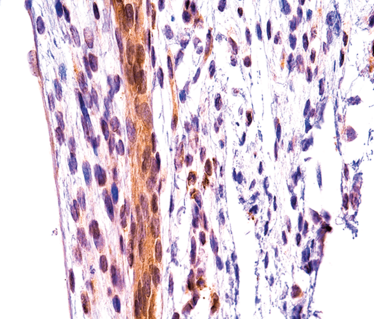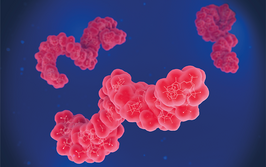Biliary Biomarker
Measuring MMP-7 levels could speed up biliary atresia diagnosis
Children born with biliary atresia face a difficult journey. Even the first step – diagnosis – is a challenge many overcome too late. Bile ducts allow bile to flow from the liver to the intestines; biliary atresia blocks that flow and bile accumulates in the liver, causing organ damage and eventually requiring transplantation. If diagnosed early, surgical intervention can restore the flow of bile and prevent complete liver failure – but, unfortunately, that often doesn’t happen.

A section of obstructed extrahepatic bile duct in a neonatal mouse that exhibits residual MMP-7 expression (brown). Cincinnati Children’s.
“The current diagnostic algorithms are complex and expensive,” says Jorge Bezerra, lead investigator of a study searching for biomarkers of the disease. Because the disease has multiple potential causes, no two cases look the same, which makes diagnosis challenging. “The best biochemical marker, gamma-glutamyltransferase (GGT), has limited specificity,” Bezerra explains. “Other investigations include ultrasound and tests to rule out other diseases. This combination takes time and delays surgical treatment. By having a better biochemical marker, one can make the diagnosis more promptly, perform a biopsy, and send the infant to surgical treatment.” The liver-sparing procedure, called a Kasai portoenterostomy, has much greater success when performed in early infancy – so an accurate molecular biomarker would be a lifesaver.
And that’s exactly what Bezerra’s team found – a protein known as matrix metalloproteinase-7 (MMP-7), which is released into the blood after injury of the biliary epithelium (1).
“MMP-7 was the protein biomarker with the highest discriminatory value for biliary atresia. Validation was performed in two additional cohorts. Immunostaining showed the highest expression to be limited to gallbladder and extrahepatic bile ducts – the main anatomic sites of injury in biliary atresia.” Even alone, MMP-7 proved a useful biomarker for biliary atresia – but its accuracy improved to 95 percent when combined with GGT.
Bezerra and his team are now measuring MMP-7 in neonates to establish normal values and developing an easy-to-perform assay for MMP-7 quantification. Soon, they hope to make the test available to clinicians for prompt inclusion into diagnostic approaches, with the goal of saving livers – and lives.
- C Lertudomphonwanit et al., “Large-scale proteomics identifies MMP-7 as a sentinel of epithelial injury and of biliary atresia”, Sci Transl Med, 9, eaan8462 (2017). PMID: 29167395.

While obtaining degrees in biology from the University of Alberta and biochemistry from Penn State College of Medicine, I worked as a freelance science and medical writer. I was able to hone my skills in research, presentation and scientific writing by assembling grants and journal articles, speaking at international conferences, and consulting on topics ranging from medical education to comic book science. As much as I’ve enjoyed designing new bacteria and plausible superheroes, though, I’m more pleased than ever to be at Texere, using my writing and editing skills to create great content for a professional audience.




















